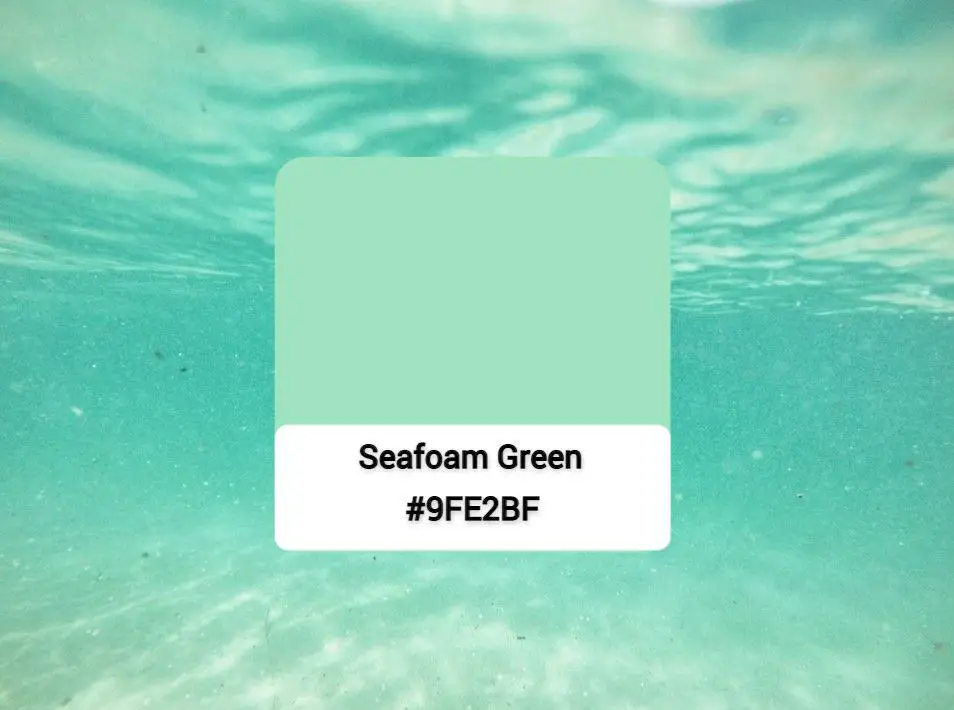Seafoam green has been a popular color choice in home decor and fashion for many years. Recently, it seems to be experiencing a resurgence in popularity as people look for fresh, soothing color palettes. But is seafoam green just a passing trend, or is it here to stay as a new neutral shade? Let’s take a look at the history of seafoam green and its use in current interior design and fashion to determine if it’s truly in style for the long run.
The History of Seafoam Green
Seafoam green gets its name from the ocean, as it resembles the soft, frothy foam that appears along the shoreline. It’s a pale, cool-toned green with just a hint of blue mixed in. This versatile hue has been popular since the 18th century and has weaved in and out of mainstream style over the decades.
In the 1700s and 1800s, the color grew popular for walls and furnishings, as it offered a refreshing change from heavy velvets and dark wood tones. Seafoam green has an association with beach homes thanks to this early use. In the 1920s and 1930s, it became a staple in Art Deco interiors and could be found on everything from furniture to tile.
Mid-century modern style embraced seafoam green in the 1950s and 1960s. Its light, airy look perfectly suited the breezy, casual decor of the time. It often appeared alongside other pastels like pink, yellow, and blue. The color fell out of favor in the 70s and 80s as bolder, more saturated colors took over. But seafoam green emerged again in the 1990s and 2000s as minimalism gained ground. Its softness aligned well with sparse, neutral interiors.
Seafoam Green in Today’s Homes
In recent years, seafoam green has become an “it” color once again in home decor and interior design. Its versatility allows it to work in many styles from bohemian and eclectic to modern and minimal. Here are some of the ways seafoam green is appearing in homes today:
– Paint Color – Seafoam walls provide a soothing backdrop in living rooms, bedrooms, and other spaces. Its flexibility to lean more green or blue makes it coordinate well with many color schemes.
– Furniture – Upholstered chairs and sofas in seafoam green add a pop of subtle color to neutral rooms. The hue is also popular for dining chairs and accent side tables.
– Textiles – From pillows and throws to rugs and curtains, seafoam green textiles can inject visual interest into any room. Pair it with neutrals or layer it with other pastels.
– Kitchen Cabinets – Seafoam cabinetry offers a refreshed, yet timeless look for kitchens. Appliances and hardware in chrome or nickel nicely complement the color.
– Bathrooms – Seafoam green makes a tranquil and relaxing color for baths and spas. Use it on walls, tile, or accessories for a spa-like vibe.
Seafoam Green Fashion Trends
Beyond interiors, seafoam green is making waves in the fashion world as well. Both couture designers and fast fashion brands have embraced this shade for its versatility and wearability. Here are some of the ways seafoam green is trending in clothing and accessories:
– Women’s Dresses – Flowy maxi dresses, fit-and-flare frocks, and slinky slip dresses in seafoam green perfectly capture the ethereal, beachy vibe of the hue. The color flatters a wide range of skin tones.
– Sweaters and Cardigans – Lightweight seafoam sweaters and cardigans serve as excellent layering pieces. They provide visual interest without overpowering an outfit.
– Shoes – From sandals to heels to sneakers, footwear in pale seafoam green instantly elevates a look. The color works year-round, not just for spring and summer.
– Handbags – Many top designers like Gucci, Kate Spade, and Mansur Gavriel offer seafoam green handbags, from clutches to totes to bucket bags. This pop of color dresses up neutral outfits.
– Activewear – Athleisure brands like Alo Yoga and Lululemon have tapped into the seafoam trend with workout gear in this soothing shade. It provides a fresh alternative to black activewear.
Is Seafoam Green Just a Passing Trend?
So does seafoam green have staying power? Or is it merely a fleeting trend? When looking at its history and versatility, seafoam green appears to have some long-term potential in both fashion and interior design. Here are a few reasons why it may have some staying power:
– Provides Visual Interest – With many homes and wardrobes awash in neutrals, seafoam green injects low-key color and visual interest into spaces and outfits without overpowering.
– Flexibility – Its ability to skew more green, blue, muted, or bright means endless possibilities. Seafoam green can work with many different aesthetics and color palettes.
– Transeasonal Appeal – Seafoam works year-round for fashion and home decor, not merely relegated to spring and summer. Its timelessness means it won’t quickly feel dated.
– Soothes and Relaxes – With its connection to the ocean, seafoam green takes on a soothing, serene quality. Given the hectic pace of life today, this relaxing color may have an enduring appeal.
– Pairs With Neutrals – Black, white, beige, gray, and other neutrals will continue as staples in design and fashion. Seafoam green beautifully complements these ubiquitous colors.
Conclusion
Seafoam green has all the makings of a new neutral shade that can stand the test of time. Its soft, tranquil quality allows it to work as an accent or take center stage in both fashion and interiors. While no color is universally flattering or appealing, seafoam green comes close with its flexibility across styles and seasons. As people continue to seek out colors that soothe and relax, this blend of pale green and blue has the potential to become a mainstream neutral in both fashion and design.


